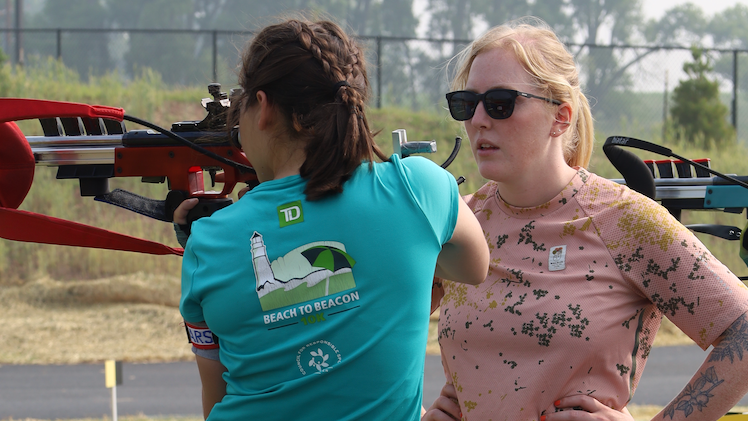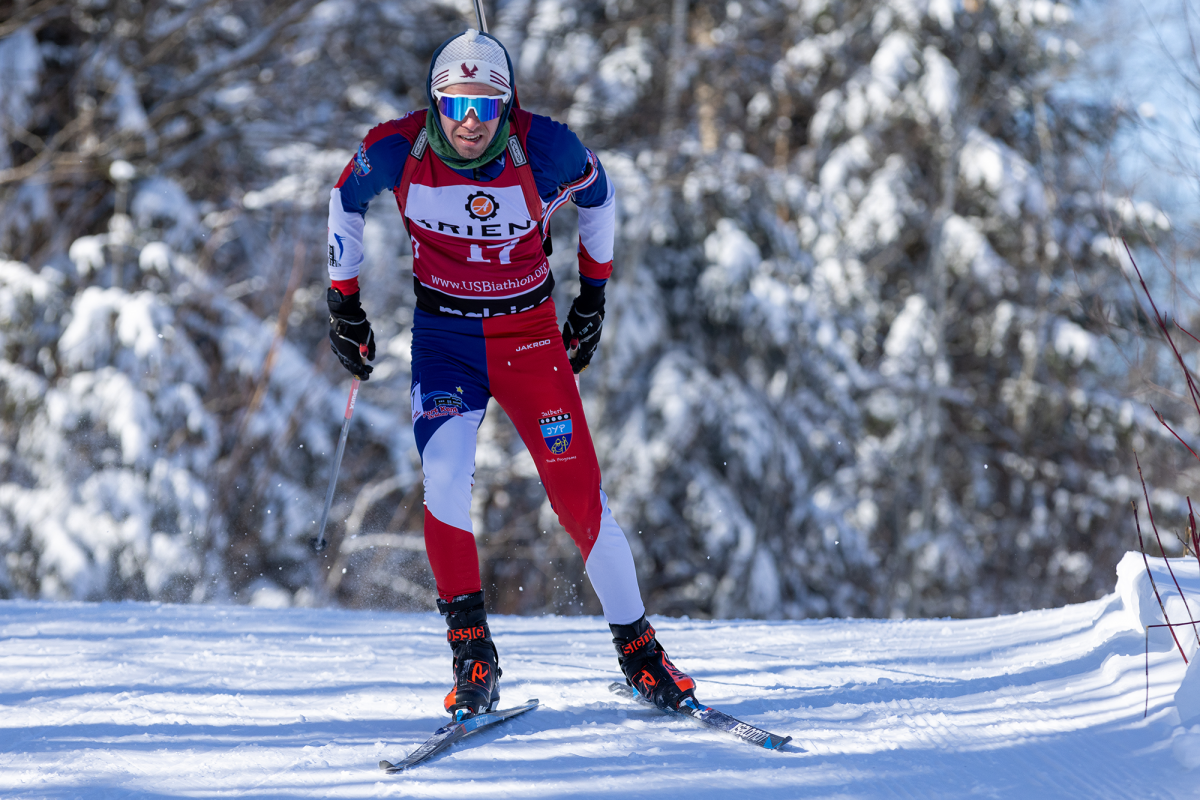
It’s hard to say which biathlete faced more pressure before the start of Saturday’s 12.5 k pursuit in Oslo, Norway: Evgeniy Garanichev of Russia, or the country’s own Emil Hegle Svendsen.
23-year-old Garanichev was coming off the first win of his career in Thursday’s sprint. After seeing just one weekend of World Cup action during the 2011 season, Garanichev started the first period of World Cups this year, but was then sent back to the second-tier IBU Cup. He won two races there and was given another chance on the big stage, but even after collecting a World Cup podium in Antholz, Italy, Garanichev said that he “wasn’t a star” and felt that his place on the World Cup squad was not a sure thing.
Svendsen, on the other hand, is definitely a star: his 26 World Cup victories place him fourth on the all-time record list. But while Svendsen and teammates Tarjei Bø and Ole Einar Bjørndalen dominated the circuit last year, this season has not been so kind to the Norwegians. Here he was on home turf, expected to give the fans what they’d come for – and what they felt they hadn’t seen enough of this season.
In the end, neither of the men – who started with bibs one and three – could pull off the victory, which went instead to a clean-shooting Arnd Peiffer of Germany, who was alone at the front after the third shooting stage.
After Peiffer cleaned the final shooting stage, Garanichev, Svendsen, and Martin Fourcade of France all missed a shot, erasing any chance to try to catch the German with an aggressive last loop of skiing; instead of chasing Peiffer, they were left to fight for second amongst themselves.
Garanichev had a seven second lead on Svendsen when he left the penalty loop, but by the time the racers had made their way up the long climb to the top of course, the Norwegian had closed the gap. With no time to enjoy the panoramic views of Oslo laid out before them, the pair descended down towards the venue’s final challenge: the Gratishaugen, a long, incredibly steep hill below the far side of the stadium.

At the 2011 skiing World Championships, the Gratishaugen had been where Marcus Hellner of Sweden put in a powerful attack in the sprint final to seal the deal on his win, prompting fans to rename the hill the “Hellnerbakken.” As Garanichev led Svendsen down the final descent towards the hill, it seemed that this pitch would surely be where the two would fight it out for second place.
But instead, they remained evenly matched, perhaps partly because a slower racer, who was being lapped, took up one lane of the hill and made passing difficult. As they rounded the corner down into the stadium proper, the pair still matched each other stride for stride.
In some ways, it made sense: Svendsen is not so much the Hellner of biathlon, but more the Petter Northug. So he waited until seemingly the very last minute to make his move: the small hill leading up and around the back of the biathlon range, where his countryman Northug had made so many attacks at the championships last March.
“It was my tactic to wait for the flat where I am the strongest, and I did that,” Svendsen said in a postrace press conference. “I knew that Evgeniy would attack on the uphills where he is strongest, so I waited and it worked pretty well.”
When Svendsen did drop the hammer, the Russian was left flat-footed. To the roar of the crowd, Svendsen skied easily through the finish line, second place secure.
When Svendsen talked to Norwegian broadcaster NRK after the race, he admitted that he had studied Northug’s strategies from the World Championships and had been excited to replicate them.
“I had Northug in mind,” he said. “It was a dream situation for me. The run-in at Holmenkollen suits me perfectly.”
And that Northug-like sprint?
“I had been looking forward to show off my sprint again,” he said. “It has been one of my strongest weapon and it’s cool.”
It may not have been a win, but the Norwegian fans would take it.
“I feel good that I am on the podium,” Svendsen said in the press conference. “I would like to have some teammates up there with me more often, but hat has not been the case. We are only halfway through the season and hopefully by the end of the year, our team will be better than we are now.”
For his part, Garanichev said that he had handled the pressure well.
“I relaxed some yesterday, so today I just tried to concentrate, work hard and succeed,” he explained in the press conference. “I did not have great speed in the first part of the competition today, but found my own tempo and my shooting was not that bad, so it was still a good day for me.”
The man who was happiest with his race, of course, was Peiffer, who had won five sprints including the 2011 World Championship sprint, but never a race in another format.
“I showed today that I can win something other than a sprint,” he said. “It was pretty exciting.”
Another Strong Showing for North Americans, Season-Best for Burke

With three men starting in the top 15 and two more in the 20’s, the North Americans were never far from the front of the race.
Lowell Bailey of the U.S. and Brendan Green of Canada got the most television attention at the beginning of the pursuit, since they had started with bibs eight and nine. And the pair cleaned both prone stages, catapulting Bailey into the top five. On the third loop of skiing, he was sitting in fourth place, near the front of a chase pack that included Svendsen and Fourcade,
“My ski speed was right where I wanted it to be,” Bailey told FasterSkier in an e-mail.
Once Bailey and Green hit the standing stages, however, their luck ran out. Both missed two shots in the first standing stage and lost several spots; Bailey also picked up a penalty in the final stage. But despite the problems on the range, they were able to finish 12th and 13th. Bailey skied the final loop in a pack with Michal Slesingr of the Czech Republic, Bjørndalen, and Andreas Birnbacher of Germany, but he ended up being outgunned in the final sprint.
“I was still fighting for the top ten at the finish,” Bailey said. “I was definitely pretty disappointed that I couldn’t hold on in the sprint with Bjørendalen, Slesingr, and Birnbacher, but that’s how it goes. I’m psyched with the result and looking forward to [the mass start] tomorrow!”
It was Bailey’s sixth top-15 finish of the season, and he is now ranked 13th in the overall World Cup standings.
Green had been just off the back of Bailey’s pack leaving the final shooting, and lost a few more seconds and crossed the finish line alone, 11 seconds behind the American. The ninth and 13th-place results in Oslo are now the best two races of his career – and today’s race came in tough circumstances

“I woke up this morning with a sore throat and a headache, but I decided that today’s race was too good of an opportunity to pass up, so I just tried to suck it up and focus on the race process,” Green told FasterSkier in an e-mail.
And that was before the equipment problems.
“About 30 seconds before my start while I was on the line ready to go, I flexed my right foot a few times and noticed something felt a bit off,” Green said. “I looked down to realize that the toe plug in the binding on one of my skis had fallen out and disappeared. It was too late to do anything at that point so I just had to roll with it.
“That was the most frustrating ski I’ve had in a long time trying to control the ski on my right foot.”
Given his ski problems, Green said that he was unfazed by his errors on the range.
“On any other day I think I would be a little frustrated with the one standing bout, but I had other things to worry about today,” he explained. “Staying in the top 10 would have been great, but I know it will come again.”
While Bailey and Green slid backwards after shooting errors, American Tim Burke picked up the slack. Burke had placed 15th in the sprint, and today shot a perfect twenty for twenty and skied the eighth-fastest time of the day.
“It’s the first 20-shot world cup race [Burke has] cleaned and it’s a huge accomplishment,” said U.S. Biathlon Association President Max Cobb. “It is a great challenge to keep your shooting routine together in the pursuit race.”
By the time he had cleaned the third stage, Burke was sitting in seventh, a position he maintained until the very end of the race. On the final loop, he caught and then skied with Evgeniy Ustyugov of Russia, and the two tried to track down Jakov Fak of Slovenia. While they came up just short, Burke was able to sprint past Ustyugov at the finish and move up to sixth place, his best finish of the season so far.
“No two ways about it, Tim was just brilliant today,” Cobb said.
Jay Hakkinen of the U.S. and Jean-Philippe Le Guellec of Canada finished 25th and 26th, putting all five North American starters in the top-30 for the second consecutive race.
Oslo seems to be good to these men, but they aren’t entirely sure why. Perhaps they just like it; Green said that Oslo was “an enjoyable venue to race at.”
Bailey agreed.
“Oslo is a great venue,” he told FasterSkier. “Spectacular views, awesome crowd, and a nation that is pretty crazy about biathlon.”
That attitude is contagious, and Bailey described an event that one would never see in North America: a nationally-televised junior biathlon race.
“I think the most impressive thing for me about Oslo this year was watching the 14- and 15-year-old Young Stars mass start biathlon race that they put on directly following the men’s sprint on Thursday,” Bailey said. “They picked 30 of the country’s best juniors (out of a field of around 600), and sent them out on the World Cup course, complete with commentary and full TV coverage. That race was shown in its entirety this morning, in between the women’s and men’s World Cup races!
“This would be like NBC broadcasting a youth biathlon race on primetime TV on a Saturday,” he concluded.





3 comments
nyctvt
February 4, 2012 at 4:03 pm
Congratulations Tim Burke for some impressive shooting, great skiing and an excellent result! Congratulations also to the rest of the US and Canadian men on your great results.
davord
February 4, 2012 at 5:03 pm
Hats off to Jakov Fak, the Croatian turned Slovenian! He’s been there or there abouts the last few years. His medal at the 2009 worlds and 2010 Olympics are definitely no flukes, plus he almost lost a finger last year due to frost bite, and still has trouble with it in cold conditions and wears the ‘big’ gloves for safety. The guy is only 24 and will only get better. It’s a pity the Slovenians don’t have the sort of funding most top nations have, otherwise you’d see more of them at the top.
gankstaskiz
February 4, 2012 at 6:12 pm
Does anyone else agree that this season has been the most phenomenal for US Biathlon and Nordic? These men and women are showing that they can not only set the bar, but raise it. Go Team.